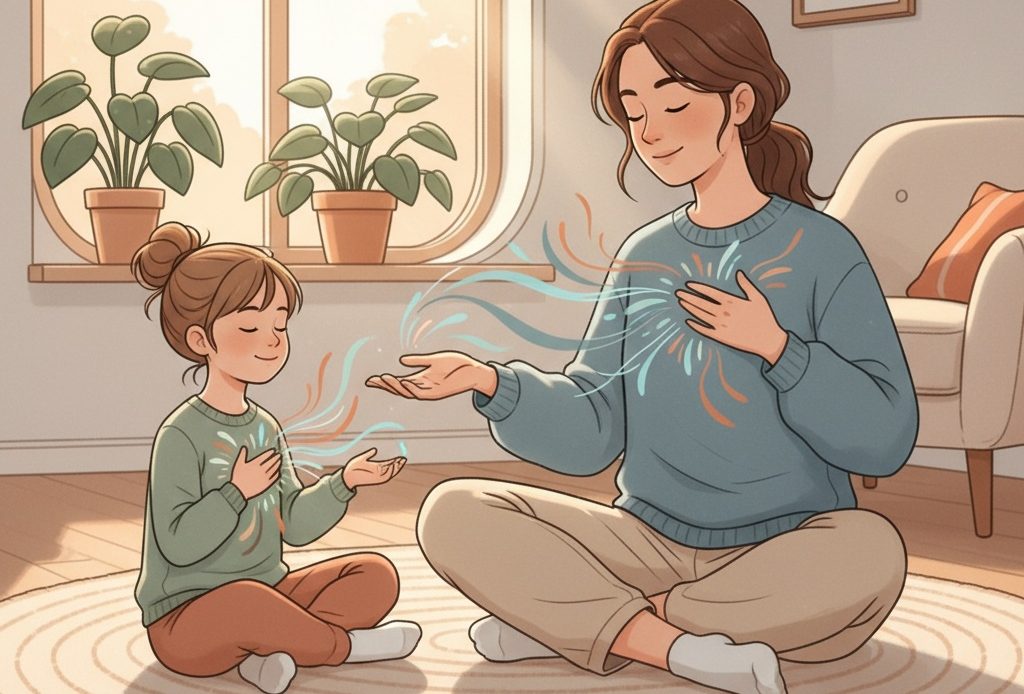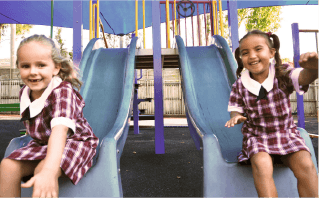
Your child is spiraling into worry again. Their breathing is shallow, their shoulders are tense, and you can see the panic building behind their eyes. You want to help, but you’re not sure what to do. You’ve tried reassurance—it doesn’t stick. You’ve tried distraction—it doesn’t work. You feel helpless watching your capable child trapped by anxiety they can’t control.
Here’s what I’ve learned in 20 years as a psychologist: anxious children don’t need more reassurance. They need tools. They need to understand what’s happening in their body and mind, and they need practical strategies they can use independently to manage their anxiety.
The good news? Anxiety is highly treatable. Evidence-based techniques like Cognitive Behavioral Therapy (CBT), mindfulness, and emotional regulation strategies work remarkably well for children ages 8-12. And the best part? These aren’t complicated therapeutic interventions reserved for psychologist’s offices. You can teach these techniques at home, and your child can learn to use them independently.
In this guide, I’ll walk you through the most effective, research-backed techniques for helping anxious children manage their emotions and build confidence. These are the same strategies I teach in my practice, adapted for parents to use at home.
Understanding the Anxiety Cycle
Before we dive into techniques, it’s important to understand how anxiety works in children’s brains and bodies. This understanding is the foundation for all effective intervention.
Anxiety follows a predictable cycle:
1. Trigger: Your child perceives a threat (real or imagined). This might be a social situation, academic challenge, change in routine, or even a thought about something bad happening.
2. Physical Response: The amygdala (the brain’s alarm system) activates the fight-flight-freeze response. Heart rate increases, breathing becomes shallow, muscles tense, digestion slows. Your child’s body is preparing to face danger.
3. Anxious Thoughts: The mind generates worried thoughts: “What if I fail? What if they don’t like me? What if something bad happens?” These thoughts feel absolutely true to an anxious child.
4. Avoidance or Safety Behaviors: Your child tries to escape the anxiety by avoiding the situation, seeking reassurance, or engaging in compulsive behaviors. This provides temporary relief.
5. Temporary Relief (But Stronger Anxiety Next Time): Avoidance works in the short term—the anxiety decreases. But this teaches the brain that the situation is genuinely dangerous. Next time, the anxiety is stronger.
The key to breaking this cycle is interrupting it at multiple points. Effective anxiety management techniques work by:
- Calming the physical stress response
- Challenging anxious thoughts
- Gradually facing fears instead of avoiding them
- Building confidence through repeated success
Technique 1: Grounding & Sensory Awareness (The 5-4-3-2-1 Method)
When anxiety strikes, children are often “in their heads”—trapped in worried thoughts and physical sensations. Grounding techniques bring them back to the present moment by engaging their senses.
How it works:
When your child feels anxiety building, guide them through this simple exercise:
Name 5 things you can SEE: “Look around and tell me five things you can see. They can be big or small.”
Name 4 things you can TOUCH: “Tell me four things you can feel. You can touch them if you want—what’s the texture?”
Name 3 things you can HEAR: “What are three sounds you can hear right now?”
Name 2 things you can SMELL: “Can you identify two smells around you?”
Name 1 thing you can TASTE: “What’s one thing you can taste?”
Why it works:
This technique interrupts the anxiety cycle by shifting attention from internal worried thoughts to external sensory experience. It activates the parasympathetic nervous system (the “rest and digest” response) and brings the child into the present moment where they’re actually safe.
In my practice, I’ve seen children use this technique to de-escalate from full panic attacks. The beauty is that it works anywhere—at school, at home, in the car—and requires no special equipment.
How to teach it:
Practice this technique when your child is calm, not during an anxiety episode. Make it a game: “Let’s see how many things we can find for each sense.” Once they’re familiar with it, they can use it independently when anxiety strikes.
Younger children (8-9) may need your guidance. Older children (10-12) can often do this alone once they’ve learned it.
Technique 2: Deep Breathing & Box Breathing
Anxiety changes breathing patterns. When children are anxious, they breathe shallowly and quickly, which signals danger to the brain and intensifies anxiety. Teaching deliberate breathing techniques gives children direct control over their nervous system.
Simple Deep Breathing (for younger children):
Belly Breathing: “Put your hand on your belly. Breathe in slowly through your nose so your belly expands like a balloon filling with air. Hold for a moment. Then slowly exhale through your mouth, letting the balloon deflate.”
Repeat 5-10 times. This activates the vagus nerve, which calms the nervous system.
Box Breathing (for older children & more effective for intense anxiety):
This technique uses a 4-count pattern:
Inhale for 4 counts (through nose)
Hold for 4 counts
Exhale for 4 counts (through mouth)
Hold for 4 counts
Repeat 5-10 times or until anxiety decreases.
Why it works:
Deep breathing directly activates the parasympathetic nervous system, counteracting the fight-flight-freeze response. The rhythmic pattern gives the anxious mind something to focus on besides worried thoughts. Research shows that controlled breathing can reduce anxiety symptoms within minutes.
How to teach it:
Use visual aids: draw a square and trace it as you breathe (one side per count), or use a breathing app designed for children. Practice daily when calm so it becomes automatic. Then your child can use it when anxiety strikes.
Technique 3: Progressive Muscle Relaxation (PMR)
Anxiety lives in the body. Tense muscles signal danger to the brain, which increases anxiety. Progressive muscle relaxation teaches children to recognize and release physical tension.
How it works:
Guide your child through this sequence, tensing each muscle group for 5 seconds, then releasing:
Hands & Arms: “Make tight fists. Squeeze as hard as you can. Now release and notice how it feels when they’re relaxed.”
Face & Jaw: “Scrunch up your face like you just ate something sour. Hold it. Now relax and let your face go soft.”
Shoulders: “Shrug your shoulders up to your ears. Squeeze. Now drop them and feel the relief.”
Stomach: “Tighten your stomach muscles. Hold. Now let them go soft.”
Legs & Feet: “Point your toes and tighten your leg muscles. Hold. Now relax.”
Why it works:
PMR teaches children the difference between tension and relaxation. It also provides a sense of control—they’re actively doing something to manage their anxiety rather than being passive victims of it. The physical relaxation signals safety to the nervous system.
How to teach it:
Practice this together for 10-15 minutes when calm. Make it fun: “Let’s see which muscle group can squeeze the hardest!” Once familiar, your child can use an abbreviated version (just the most tense areas) when anxiety strikes.
Technique 4: Cognitive Restructuring (Challenging Anxious Thoughts)
Anxious children get stuck in thought patterns. They catastrophize, assume the worst, and treat worried thoughts as facts. Cognitive restructuring teaches them to examine and challenge these thoughts.
The Process:
Step 1: Identify the Anxious Thought
Help your child name the worried thought: “What’s the thought that’s making you anxious right now?”
Common anxious thoughts in children include:
- “I’m going to fail the test and everyone will think I’m stupid.”
- “Something bad is going to happen.”
- “They don’t like me.”
- “I can’t do this.”
- “What if I mess up?”
Step 2: Examine the Evidence
Ask gentle questions to help your child examine the thought:
“Is that thought definitely true, or is it something you’re worried might happen?”
“What evidence do you have that this will happen?”
“Has this happened before, or are you imagining it might happen?”
“What would you tell a friend who had this same worry?”
Step 3: Generate a More Realistic Thought
Help your child develop a more balanced, realistic thought:
Anxious thought: “I’m going to fail the test and everyone will think I’m stupid.”
More realistic thought: “I’ve studied for this test. I might not get everything right, but I’m prepared. Even if I don’t do perfectly, that doesn’t make me stupid. One test doesn’t define me.”
Why it works:
Anxious children treat worried thoughts as facts. Cognitive restructuring teaches them to question these thoughts and develop more balanced perspectives. This doesn’t mean forcing positive thinking—it means thinking more realistically.
How to teach it:
Start with small worries. Practice this technique regularly so it becomes automatic. Eventually, your child can do this internally without your guidance.
Important note: This technique works best for children 9 and older who have developed more abstract thinking. Younger children may need more concrete, behavioral strategies.
Technique 5: Exposure & Gradual Facing of Fears
Avoidance is anxiety’s best friend. Every time a child avoids something, anxiety grows stronger. The most powerful anxiety treatment is gradually facing fears in a controlled, supported way.
How it works:
Step 1: Identify the Fear Hierarchy
Work with your child to list anxiety-provoking situations from least to most anxiety-producing. Rate each on a scale of 1-10.
Example (for social anxiety):
- Sitting near someone at lunch (3/10)
- Saying hello to a classmate (5/10)
- Joining a group conversation (7/10)
- Attending a birthday party (9/10)
Step 2: Start with the Least Anxiety-Provoking Situation
Begin with situations that cause mild anxiety (3-4/10). Support your child in facing the situation while using their coping strategies.
Step 3: Stay in the Situation Until Anxiety Decreases
This is crucial. If your child leaves the situation while anxious, they learn that anxiety is dangerous and escape is necessary. If they stay, anxiety naturally decreases (usually within 20-30 minutes), and they learn that they can handle it.
Step 4: Celebrate Success & Move to the Next Level
Once your child successfully faces a situation, anxiety about that situation decreases. Move to the next level on the hierarchy.
Why it works:
This is called “exposure therapy” and it’s the most evidence-based treatment for anxiety. It works because it teaches children that: (1) the feared situation isn’t as dangerous as they thought, (2) they can handle it, and (3) anxiety naturally decreases with time.
How to implement it:
This requires patience and consistency. Don’t force your child into high-anxiety situations. Build gradually. Your calm, supportive presence is crucial—your child needs to see that you believe they can do this.
Important: If anxiety is severe, work with a psychologist who specializes in childhood anxiety. They can guide this process and ensure it’s done safely and effectively.
Technique 6: Mindfulness & Present-Moment Awareness
Anxious children live in the future, imagining worst-case scenarios. Mindfulness brings them into the present moment where they’re actually safe.
Simple Mindfulness Exercise for Children:
The Mindful Eating Exercise:
Give your child a small food item (raisin, piece of chocolate, berry). Guide them through:
“Look at it closely. What colors do you see? What shape is it? Now smell it. What does it smell like? Now put it in your mouth but don’t chew yet. What does it feel like on your tongue? Now slowly chew it. What do you taste? Notice how the flavor changes.”
This teaches mindfulness in a concrete, engaging way.
Body Scan Meditation (for older children):
“Lie down comfortably. Starting at the top of your head, notice each part of your body. Don’t try to change anything—just notice. Move slowly down: forehead, eyes, nose, mouth, jaw, neck, shoulders, arms, hands, chest, stomach, back, hips, legs, feet. If your mind wanders to worries, gently bring it back to noticing your body.”
Why it works:
Mindfulness interrupts the worry cycle by anchoring attention to the present moment. Research shows that regular mindfulness practice reduces anxiety symptoms and increases emotional regulation in children.
How to teach it:
Start with short practices (5 minutes). Use apps like Calm or Insight Timer designed for children. Practice regularly—mindfulness is like a muscle that gets stronger with practice.
Technique 7: The Worry Time Strategy
Some anxious children worry constantly throughout the day. This technique gives their worry a designated time and place, which paradoxically reduces overall worry.
How it works:
Step 1: Designate a “Worry Time”
Choose a specific 15-minute window each day (not close to bedtime). This is your child’s designated time to worry.
Step 2: When Worries Arise Outside Worry Time
When your child brings up worries during the day, say: “That’s a good worry to think about. Let’s write it down and save it for worry time tonight.”
Step 3: During Worry Time
Review the written worries. Discuss them, problem-solve if possible, or simply acknowledge them. The key is containing worry to this specific time.
Step 4: After Worry Time
When worry time ends, move on to something pleasant. This teaches the brain that worry has a beginning and end.
Why it works:
This technique works because it acknowledges that worry is real and valid (you’re not dismissing it), but it also sets boundaries. Many children find that once they know they have designated worry time, intrusive worries decrease throughout the day.
How to implement it:
This works best for children 9 and older. Consistency is key—stick to the same time each day.
Building a Coping Toolkit
The most effective approach combines multiple techniques. Help your child build a personalized “coping toolkit” with strategies that work for them.
Create a Coping Card:
Write or draw the techniques your child finds most helpful on a card they can carry or keep on their phone:
- 5-4-3-2-1 Grounding
- Box Breathing (4-4-4-4)
- Progressive Muscle Relaxation
- Challenging Anxious Thoughts
- Mindfulness Exercise
- Worry Time
Practice Regularly:
Don’t wait until anxiety strikes to practice these techniques. Regular practice when calm makes them automatic and accessible during anxious moments.
Celebrate Small Wins:
When your child uses a coping strategy successfully, acknowledge it: “I noticed you used your breathing technique when you felt worried. That took courage and it helped you calm down.”
When to Seek Professional Help
These techniques are powerful and many anxious children improve significantly with parental support and practice. However, if anxiety is severe or not improving, professional help is important.
Consider consulting a psychologist who specializes in childhood anxiety if:
- Anxiety is significantly interfering with school, friendships, or family life
- Your child has panic attacks or severe physical symptoms
- Anxiety is worsening despite your efforts
- Your child has other mental health concerns (depression, OCD)
- You feel overwhelmed or unsure how to help
Evidence-based treatments like Cognitive Behavioral Therapy delivered by a trained professional are highly effective and can accelerate your child’s progress.
The Power of Your Support
As a psychologist and a mother, I can tell you this: the most powerful predictor of a child’s ability to manage anxiety isn’t the technique itself. It’s having a calm, supportive adult who believes in them and models healthy coping.
When you stay calm during your child’s anxiety, you teach them that anxiety isn’t dangerous. When you gently encourage them to face fears instead of avoiding them, you teach them that they’re capable. When you practice these techniques alongside them, you teach them that managing emotions is a skill everyone needs.
Your child’s anxiety won’t disappear overnight. But with consistent practice of these evidence-based techniques, combined with your patient support, they can learn to manage their anxiety and build genuine confidence in their ability to handle life’s challenges.
The capable, wonderful child you know is still there. These techniques help anxiety stop blocking their light.
Related Articles
10 Signs Your Child Has Anxiety (Ages 8-1)
The Power of Journaling for Kids with Anxiety
Do’s and Don’ts to Help Your Child Cope With Anxiety
Referece
Headspace (Australia). “Anxiety in Young People – Managing Anxiety.” https://headspace.org.au/




